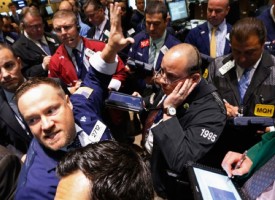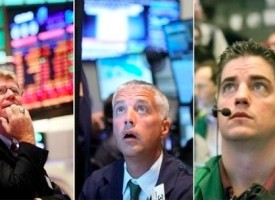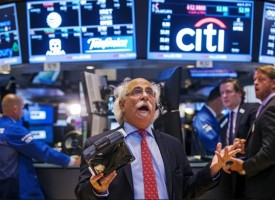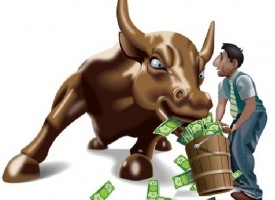Today the top trends forecaster in the world, Gerald Celente, just issued his most important series of global forecasts ever.
The “Greatest Depression” – It’s In The Numbers
October 9 (King World News) – Gerald Celente: All around the world, as markets cool, political unrest heats up.
It’s all part of the “Greatest Depression”: when people lose everything and have nothing left to lose, they lose it… and the markets are losing it, too.
The global slowdown will accelerate and equity markets will decline. It’s in the numbers…
BONUS INTERVIEW:
To listen to billionaire Eric Sprott discuss his prediction for skyrocketing silver
as well as his top silver pick CLICK HERE OR BELOW:
Mergers and acquisitions have fallen 11 percent so far this year, as companies brace for periods of growing economic uncertainty.
To keep the cheap money flowing, more than 30 central banks around the globe have lowered their interest rates this year and dozens are expected to cut their rates again next quarter.
Last week, the Australian central bank dropped interest rates, already at their lowest in history, to a new low of 0.75 percent.
India also cut its rates again last week, bringing them down to 5.15 to 5.40 percent in hopes of propping up their slowing economy.
With auto and motorcycle sales dramatically down, consumer spending markedly slowing, and fears of a cash crunch, India’s central bank tweeted out assurances that there will be “plenty of dough for depositor.” They claimed the reports of bank instability were “rumors.”
China, the world’s second-largest economy, posted its slowest economic growth since 1990. To date, government measures have failed to reverse the trend.
Refusing to aggressively lower rates, Chinese attempts to boost the economy with fiscal policy, such as infrastructure spending, have failed. Infrastructure investment is up only 4 percent from January to August compared with 20 percent only two years ago.
Moreover, Chinese private bond defaults are up 60 percent in the first eight months of the year.
Over in Europe, in addition to playing the monetary stimulus card, the European Central Bank’s President Mario Draghi called for “unity,” urging member states of the Eurozone to commit to fiscal spending.
However, numerous European nations, including Germany, which is slowing into recession, are opposing the ECB’s stimulus mandate. They want to keep their budgets balanced and are not willing to drag their nation into debt.
On the bankster side, to boost fees lost because of low interest rates, down about 20 percent this year, banks increased their lending to corporations eager to borrow cheap money.
Thus, the $250 trillion global-debt bubble continues to swell.
1st TREND FORECAST:
Be it monetary or fiscal stimulus, it’s becoming increasingly clear that neither measure – although they might temporarily boost sagging economies – will not reverse the oncoming Greatest Depression.
However, we forecast that U.S. equities have topped out and as the impeachment process against President Trump accelerates it will push them much lower.
Further, as economies continue to decline, social unrest will dramatically escalate as evidenced in nations from South America to Africa, from Asia to the Middle East, and from Europe…soon to the United States.
AMERICA: WE’RE NOT BUYING IT
Typically, consumer spending, accounting for some 70 percent of America’s Gross Domestic Product, has been holding.
But now there’s a slowdown in sight. It’s up only 0.1 percent, the weakest it’s been in 6 months.
Deep in debt, and with last week’s data showing stagnant wage growth, ”borrowing more to buy little” is now becoming the American way.
Can’t afford those new Nike sneakers? Don’t worry: You can buy them in just four easy installments! And no layaway necessary!
Financial tech startups now offer these payment plans as part of your speedy online checkout.
2nd TRENDPOST:
This Borrow More, Buy Little will be a growing trend and not only in the United States, but across developed nations. The tech startups offering these loans will be siphoning revenue from the credit card industry.
Trends are born, they grow, mature, reach old age, and die. The Borrow More, Buy Little trend has just been born.
To date, there are no dominant “PayPals” in this new sector. Identifying and investing in the hottest of these buy-on-installment startups will attract strong stock market attention.
You Can’t Drive a House
Car loans in the US, which were once a measure of the financial health of the middle class, are getting bigger and taking longer to pay off.
Roughly 33 percent of auto loans take at least 6 years to pay off, up from 10 percent a decade ago. With the average cost of a new car being $34,000, in part due to safety features and computerization of the dashboard, more people will live in their cars rather than buying a house.
Not only will debt burdens escalate as wages decline, but also defaults will skyrocket when the Greatest Depression hits.
As for filling the gas tank, the US shale boom is finally slowing, although production is still significant and reaching its peak.
The decline is the result of operational mishaps, such as drilling too close to other wells and overestimating the amounts in tapped locations.
Despite less supply, there will also be less demand as the global economy continues to cool.
3rd TREND FORECAST:
As we go to press, oil prices continue to slump, with Brent Crude down to around $58 a barrel. As the headwinds of the Greatest Depression approach, we forecast that, absent major war in the Middle East, oil prices will fall into the $30 to $40 range per barrel.
Skylines for Sale
From car sales to high-rises, the financial squeeze is being felt from bottom to top.
The average price of a Manhattan apartment fell to just under $2 million, a 32 percent decline. Real estate agents attribute it to a state-transfer tax.
Yes, in part. However, we attribute it to stagnant wages and “real” inflation numbers, not the fake ones the government spews, and declining job opportunities that pay living wages.
Meanwhile, rents are astronomical in major coastal cities.
The median rent for a single-bedroom pad in the Big Apple is $2,970 per month.
A “studio” rental in San Diego made headlines: This 200-square-foot stand-alone property was going for $1,050 per month.
To be awarded this honor, the potential occupant needs a credit score upward of 650 and an income of at least 2.5 more than the monthly rent.
Despite what we forecast as a questionable future in real estate as the Greatest Depression looms, foreign institutions and pension funds are investing in commercial real estate in New York.
Low interest rates and shaky stocks make real estate appealing in a market in which a fifth of all government bonds yield zero, sometimes negative, interest.
And they’re buying up these hyperexpensive commercial properties, despite being vacant for years, while big-name stores close their doors on Fifth Avenue and in other hot retails spots in the City.
Online, Not on Foot
Seeing the online future, the Blackstone Group (one of the largest private and alternative investment firms in the world) continues to buy up industrial warehouses across the US and Europe.
They just closed one of the biggest private real-estate deals in history, paying $5.9 billion.
No more window shopping at brick-and-mortar storefronts. Warehouses are needed for retail goods bought online and delivered to your doorstep.
The future is in e-commerce.
4th TREND FORECAST:
Housing prices are also climbing in Europe, at approximately 4 percent per year. As cities become too expensive to live in, our Organic Growth Cities trend forecast (Trends Journal, July 2018) will strengthen.
Just last year alone, tens of thousands of mostly Millennials and Gen Xers moved from major cities, such as New York, Chicago, San Francisco, and Las Vegas, to the enduring, old-fashioned towns that once exemplified the hometown of the American Dream.
This will only intensify, particularly as crime rates rise when the Great Depression worsens, and more people escape to safer-haven towns and cities.
Don’t Bank on Banking Jobs
To add insult to already shrinking bankster profit injury, HSBC has announced it will slash 10,000 jobs, eliminating over 4 percent of its workforce. This follows the 60,000 layoffs this year by Deutsche Bank, Barclays, Citigroup, and others.
The next decade looks grim for all banking staff in the branches, call centers, and corporate headquarters.
In addition to positions being dropped in the name of “redundancy,” analysts say advances in automation, such as chatbots, will cause an estimated 200,000 lost jobs over the next 10 years, the biggest reduction of jobs in banking history.
5th TRENDPOST:
As we go to press, Federal Reserve Chairman Jerome Powell announced QE4, but wouldn’t call a spade a spade.
“This is not QE. In no sense is this QE,” he said referring to the Fed’s pumping in more cheap money in the troubled overnight lending markets.
Some two weeks ago, when the repo markets were short of cash and interest rates spiked from around 2 percent to 10 percent, the Federal Reserve Bank of New York said they would keep the money flowing until this Thursday, 10 October.
Then last week, when the overnight money junkies needed more monetary methadone, the New York Fed said they would keep the fix going till November as we reported last week in the Trends Journal.
Zero Hedge claims the real reason why the Fed is injecting more money into the system Is that “the US has facing an avalanche of debt issuance and with China and Japan barely able to keep up, someone has to buy this debt. That someone: the Fed.”
The Feds action and central banks money-pumping schemes will not save failing economic systems.
As we noted since they launched QE and zero interest rate policy following the Panic of ‘08, the data proves they only enriched the one percent at the expense of the workers of Slavelandia.
Just yesterday the Bank of International Settlements confirmed our analysis, writing that “the unprecedented growth in central banks’ balance sheets since the financial crisis has had a negative impact on the way in which financial markets function.”
6th TREND FORECAST: $3,000 To $5,000 Gold
The more cheap money backed by nothing and printed on nothing that flows into the systems, the higher gold prices will spike.
While our long stated forecast was for gold to steadily rise to $2,000 per ounce this year and early next year, considering these new rounds of aggressive monetary stimulus measures being taken by governments and central banks globally, a range of $3,000 to $5,000 per ounce is on the horizon…If you subscribe to the Trends Journal for less than 29 cents a day these are the kind of updates you can expect each week, CLICK HERE to subscribe.
Fred Hickey On Gold & Silver, Plus Stunning Charts & Info
READ THIS NEXT! Fred Hickey On Gold & Silver, Plus Some Stunning Charts & Info CLICK HERE TO READ
KWN has released David Stockman’s powerful audio interview discussing the gold market and much more and you can listen to it by CLICKING HERE OR ON THE IMAGE BELOW.
More articles to follow…
ALERT: Important Update On The Gold Market CLICK HERE TO READ
Gold Surges Back Over $1,500, Silver Advancing Toward $18 As Dow Plunges 300 CLICK HERE TO READ
Look At Who Got Sucker Punched CLICK HERE TO READ
What Is Happening Around The World Is Unbelievable CLICK HERE TO READ
© 2019 by King World News®. All Rights Reserved. This material may not be published, broadcast, rewritten, or redistributed. However, linking directly to the articles is permitted and encouraged









